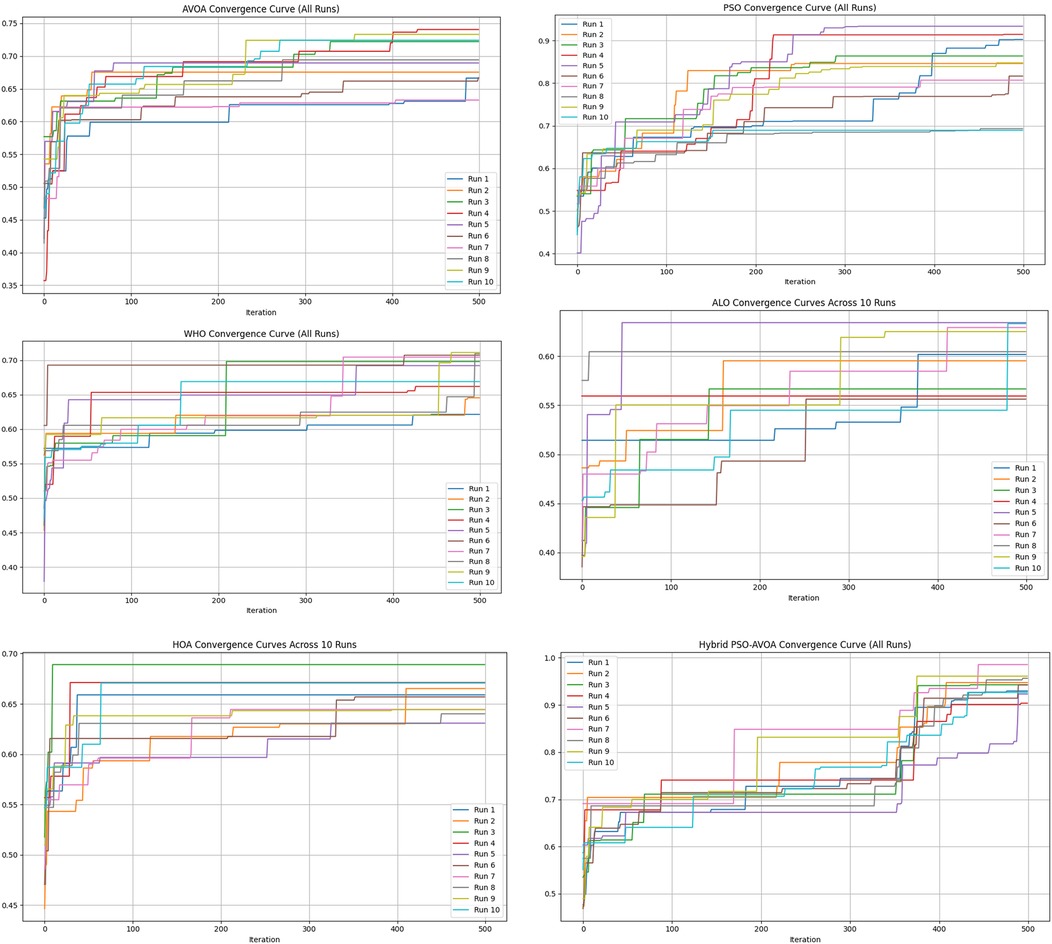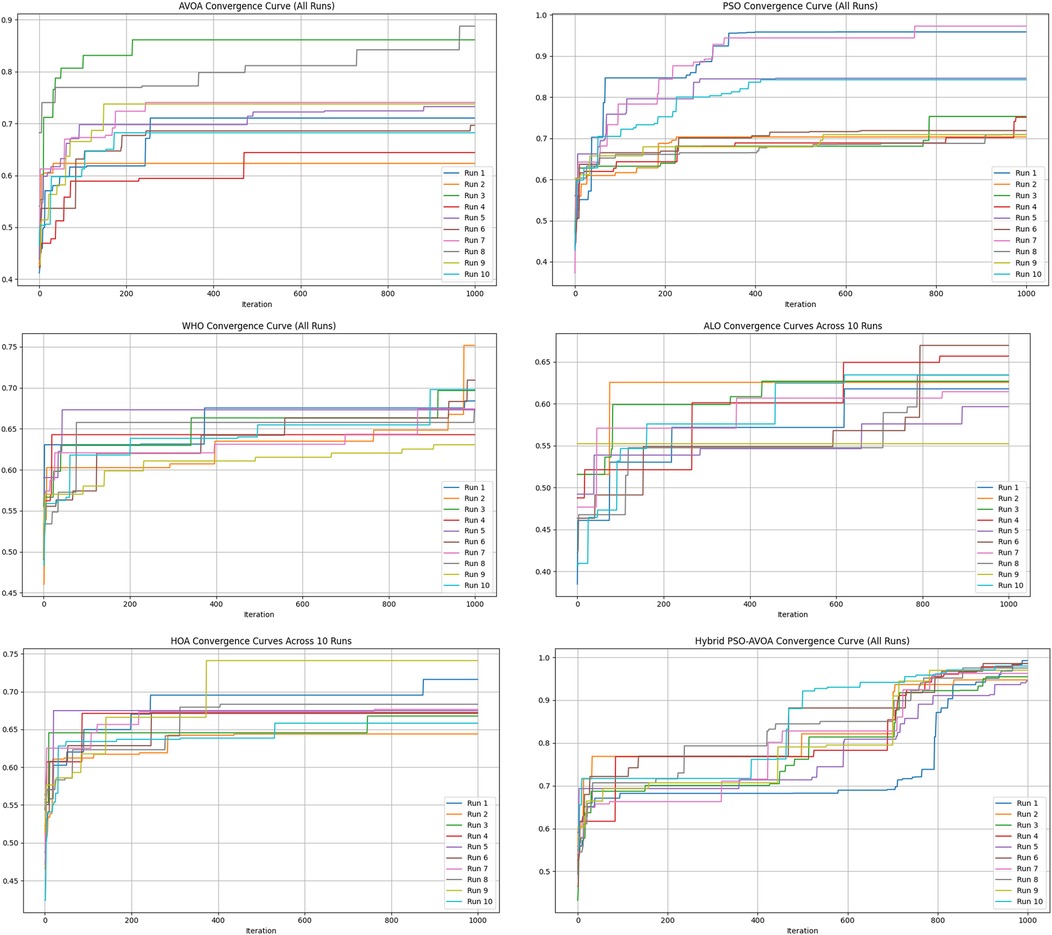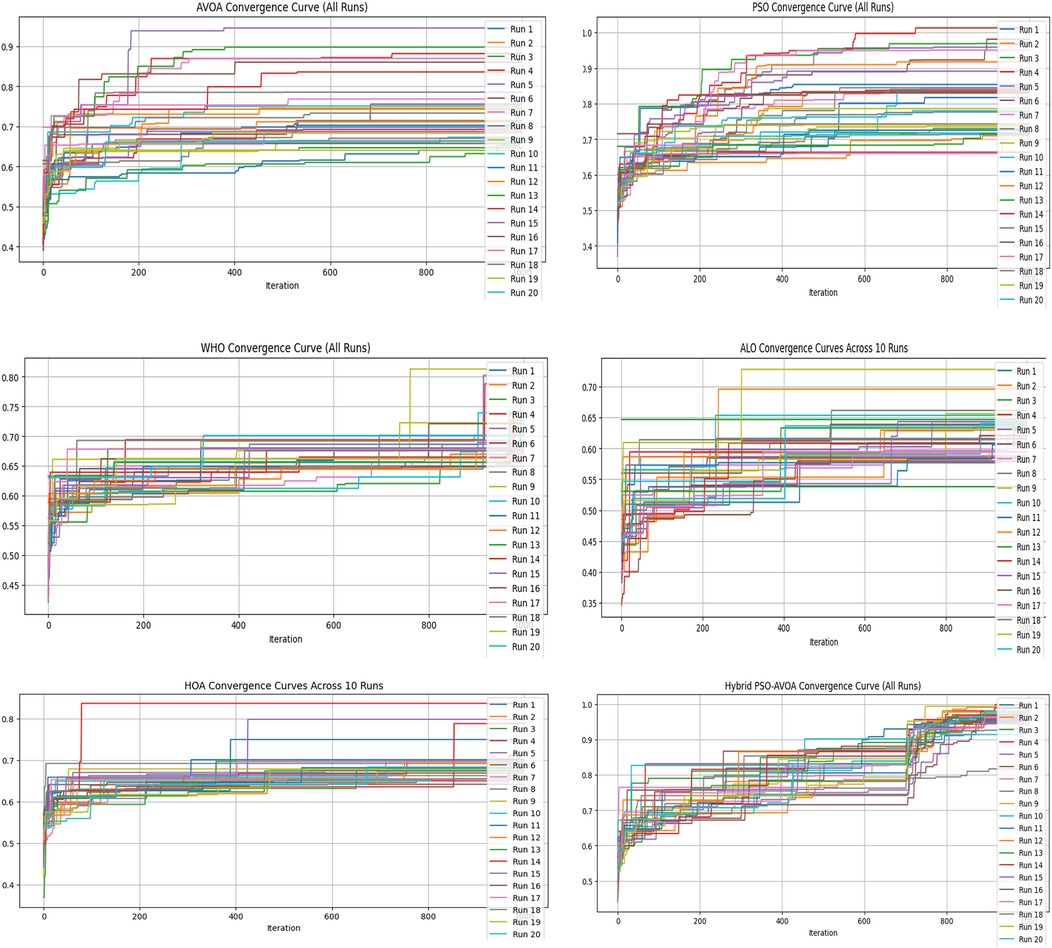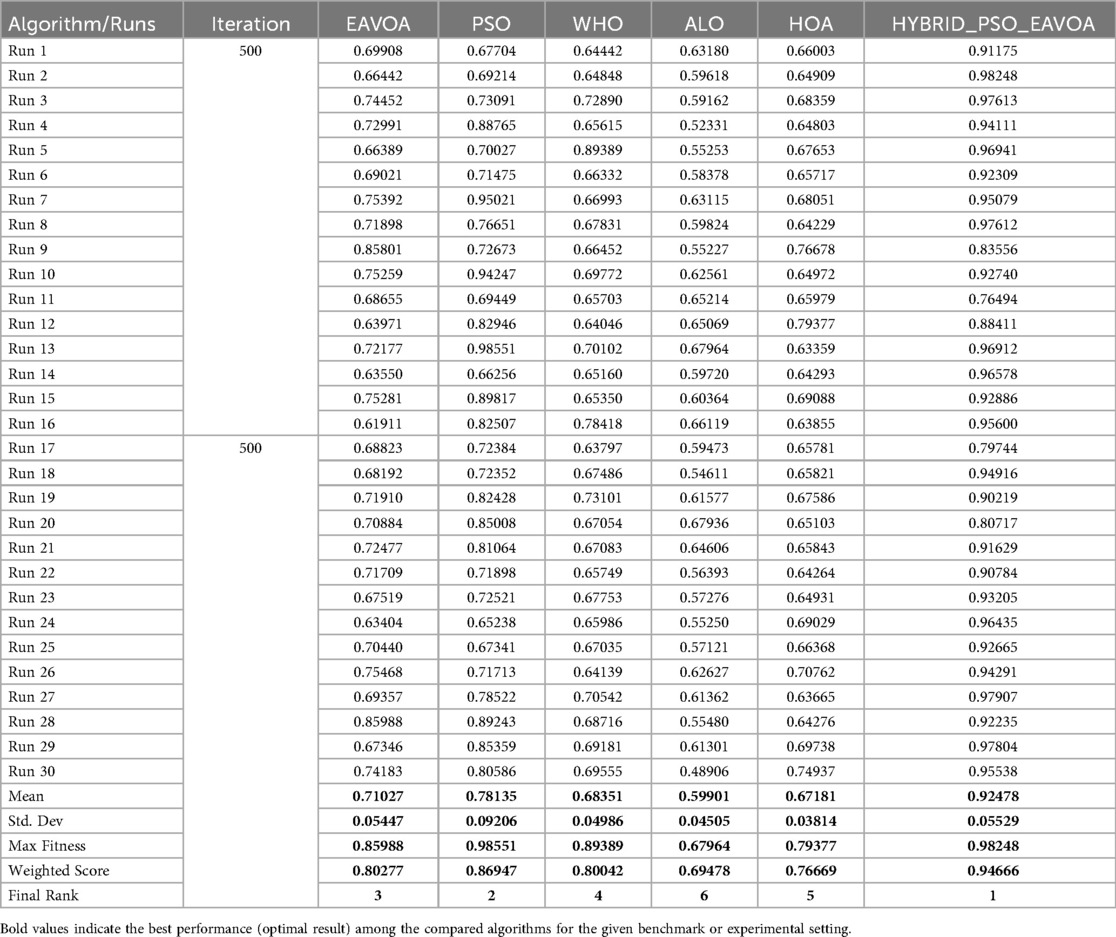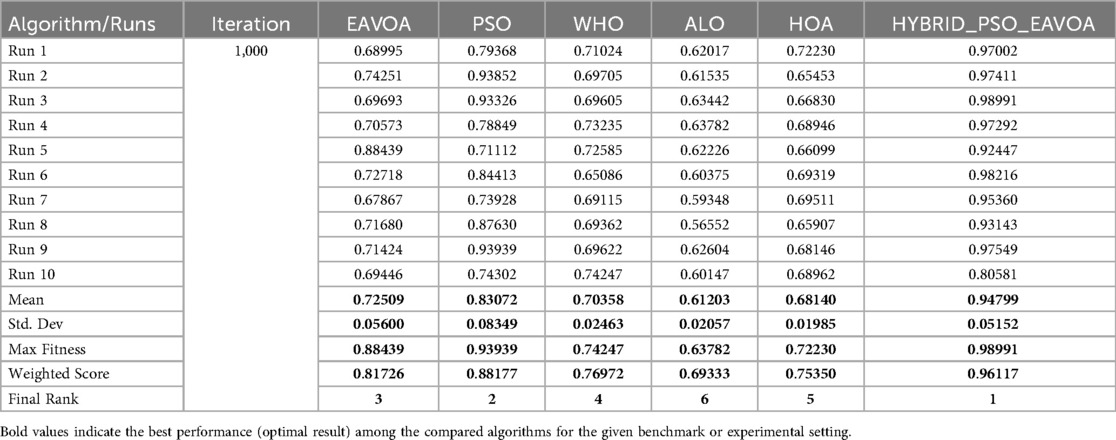- School of Computer Science and Engineering, Vellore Institute of Technology, Chennai, India
Introduction: Patient-generated drug reviews are becoming increasingly available and serve as a rich source for computational drug prioritization.
Methods: In this study, we developed a Hybrid Particle Swarm-Enhanced African Vulture Optimisation Algorithm (Hybrid PSO-EAVOA) that fosters the development of better balances between the exploration and exploitation of which the framework uses the improved opposition-based learning, Levy flights, and elite preservation approaches. In the framework, multiple evaluation criteria are accommodated, recovering value in the form of an overall single-objective optimization scheme, where effectiveness, side-effects, and consistency of reviews were compiled for clinical significance and combined by a weighted-sum fitness function. To validate the experiment using a large-scale dataset of drug reviews obtained from the Drugs Side Effects and Medical Condition dataset sourced from Drugs.com in Kaggle.
Results: Hybrid PSO-EAVOA performed a benchmark comparison against five state-of-the-art metaheuristic algorithms (PSO, EAVOA, WHO, ALO, and HOA) using varying iterations as runs. In each comparison, Hybrid PSO-EAVOA achieved superior or better convergence speed, robustness, and quality of solutions.
Discussion: The specific method of weighted-sum aggregation was used in this study, the framework offered could be easily compatible with other forms of aggregation. Hybrid PSO-EAVOA demonstrates strong potential for broader application in fields such as pharmacovigilance, clinical decision support, and drug re-purposing. The dataset is publicly available on Kaggle Drugs Side Effects and Medical Condition and all source code for parameter settings and preprocessing scripts is publicly available at the GitHub repository https://github.com/suruthi-m/Hybrid_PSO_EAVOA.
1 Introduction
Personalized healthcare is evolving and data-driven, intelligent decision-support systems have become increasingly important. Electronic health records, user-sourced reviews and metadata regarding drugs provide many opportunities and challenges in optimizing drug selection (1). Developing personalized medication decisions requires assessing several variables, including efficiency, side effects, comorbidities, demographic characteristics and user notes. Rule-based (or simple statistical model) approaches typically will not work well for the complexities and high dimensionality of real-world clinical scenarios, especially with incomplete or heterogeneous data sources (2, 3). This complexity has created interest in applying artificial intelligence (AI) and nature-inspired metaheuristics algorithms to the drug recommendation problem. The clinical goals and objective functions to model drug choice as a multi-criteria optimization problem while considering the variability in response to individual drugs. In addition, while categorically textual and non-linear data types (like drug treatment classes, side effect summaries and the sentiments of users) have to realize that normal recommender systems may not always apply to the clinical selection of drugs. Collaborative filtering and supervised learning techniques were successfully applied in types of industries such as e-commerce (4), but they require labelled data and rely on static user preferences and do not perform well in sparsely populated or dynamically changing medical environments (5).
Addressing the limitations involves, metaheuristic optimization algorithms have recently emerged as popular alternatives due to their ability to conduct exploration in complicated and nonlinear search spaces without imposing gradient information. Nature-inspired algorithms, like Particle Swarm Optimization (PSO) (6), Ant Lion Optimization (ALO) (7) and Enhanced African Vulture Optimization Algorithm (EAVOA) (8) are showing remarkable results across a wide range of applications in the areas of feature selection, image segmentation, drug discovery and scheduling problems. The design of nature-inspired algorithms integrates the trade-off between global exploration and local exploitation, which is beneficial in high-dimensional search spaces. Current improvement designs such as hybridization strategies and adaptive control methods continue to enhance such metaheuristic optimization algorithms’ convergence and performance (9, 10).
Despite these advancements, there is still little to no dedicated research that applies these algorithms straight to real clinical data for personalized drug recommendation. Indeed, most studies currently rely on purely synthetic benchmark datasets, or study the algorithms under ideal situations that do not represent the complexities of real patient data. Moreover, few methods even take into account multiple evaluation metrics—such as drug effectiveness (user rating), side effect severity (side effect descriptions) and strength of consensus (number of reviews)—in a unified, healthcare-oriented optimization framework. This study aims at bridging the gap, this work presents the Hybrid Particle Swarm Optimization–Enhanced African Vulture Optimization Algorithm (Hybrid PSO–EAVOA) and uses it for intelligent drug choice using a real clinical dataset from Drugs Side Effects and Medical Condition dataset sourced from Drugs.com in Kaggle (11). The real dataset contains abundant information including normalized user ratings, patient-and drug-related features, category- and class-based information and side effect descriptions. The Hybrid PSO-EAVOA combines the global search optimization potential of PSO and the feeding behaviour of EAVOA with methods in the literature such as Levy flight-based mutation techniques (12), oppositional-based learning (13) and dynamic parameter selection (14).
The proposed method constitutes several key innovations that improve the solution to the challenging problem of personalized drug selection. The first innovation is a custom multi-criteria fitness function that assesses subsets of drugs from three important healthcare perspectives: high therapeutic efficiency (provided by average user ratings), low adverse effects (indicated by side effect length), and high degree of user consensus (measured by the number of reviews). This means it will allow a fit fitness function to produce drug selections, which will offer a more accurate prediction of clinical outcomes. The second innovation to ensure population diversity, therefore minimizing premature convergence, is the introduction of Levy flight perturbations that make the algorithm capable of long-distance moves in the solution space, consequently improving the global search capabilities of the algorithm. A third innovation is that the method employed adaptive inertia weights and acceleration coefficients to progressively realize the advantages of inertia and balance exploration (in the early iterations) with exploitation (in the later iterations). A fourth innovation is the use of opposition-based learning during the initialization of the algorithm to facilitate an initial population of dissimilar individuals, showing faster convergence. Finally, the algorithm employs elite preservation and restart strategies to carry the best solutions from generation to elite preservation and to be able to recover from being stuck (through re-entrenchment) by bringing back diversity into the search space. Together, these advances form a stronger, more adaptable and clinically relevant optimization framework for drug recommendation.
To evaluate the efficiency of the proposed hybrid algorithm, a large-scale experimentation was carried out over multiple runs. The proposed hybrid is compared to five already established nature-inspired approaches, Enhanced EAVOA (15), Particle Swarm Optimization (PSO) (16), Wild Horse Optimizer (WHO) (8), Ant Lion Optimizer (ALO) (17) and Hippopotamus Optimization Algorithm (HOA) (18), These approaches are selected and drawn from the literature based on the performance parameters. The experimental assessment focused on convergence characteristics, best fitness values and consistency in selecting effective drug subsets in a common way through the iteration process. Through empirical evidence, the hybrid PSO–EAVOA outperformed the existing baselines in both robustness and solution quality, while providing superior convergence time and probability-based suggestion quality.
In this paper, Hybrid PSO–EAVOA, for multi-criteria drug prioritization. The rapid convergence capability of PSO and the adaptive exploration mechanics of EAVOA are well amalgamated in this framework and are further reinforced by Levy-flight perturbations, oppositional-based learning, adaptive parameter adaption and elite preservation to achieve a proper trade-off between exploration and exploitation behaviors. A tailored multi-criteria fitness function is defined such that drug effectiveness, side-effect severity, and user consensus are evaluated concurrently, leading to clinically relevant recommendations. Contrary to existing methods, which are trained on the synthetic benchmark, we evaluate the proposed model on the real-world Drugs, Side Effects and Medical Condition dataset from Kaggle. Comprehensive experimental comparisons with five state-of-the-art metaheuristics (PSO, EAVOA, WHO, ALO, HOA) illustrate better convergence, robustness and solution quality.
In summary, this research investigates a number of developing contributions to the field of intelligent health care optimization. It proposed a hybrid optimization approach, applied to the emerging case of real-world drug recommendations; it included a multi-faceted evaluation criteria based on patient-centric health requirements; and finally, it demonstrated superior performance on a previously collected clinical-based dataset. The overall results demonstrate the “real-world” applicability of the proposed Hybrid PSO–EAVOA in a clinical decision-support framework and potential application towards improving therapy planning in a personalized way.
2 Standard PSO and standard enhanced EAVOA
2.1 Particle swarm optimization
The Particle Swarm Optimization algorithm (PSO) was established by James Kennedy and Russell C. Eberhart in 1995 (16). The simulation of the social psychological manifestation of fish and birds inspires this algorithm. PSO consists of two terms, as shown in Equations 1–3
where
and . is the velocity of the member of the particle at iteration numbers (t) and (t + 1). r1 and r2 are Random numbers (0,1).
2.2 Standard enhanced African vulture optimization algorithm (EAVOA)
The Enhanced African Vulture Optimization Algorithm (EAVOA) is an algorithm inspired by nature, specifically mimicking the intelligent foraging strategies and survival characteristics of Enhanced African vultures (15) and (19). While the original EAVOA performs adequately against many global optimization problems, it is limited by its slow convergence speed and difficulty in avoiding local optima when optimal solutions are complex with high dimensionality.
To enhance the solution capability of the EAVOA, the Enhanced African Vulture Optimization Algorithm (EAVOA) was designed. The EAVOA offers three mechanisms to improve the EAVOA:
2.2.1 The Representative Vulture Selection Strategy (RVSS) mechanism allows for dynamic leader selection from the best, second-best, or newly created solution. Based on an established starvation rate and relative fitness, this allows the solution's global search to improve and reduces the likelihood of premature convergence.
The selection probability is defined as shown in Equations 4–6:
where
2.2.2 Rotating Flight Strategy (RFS), based on the vultures’ habit of circling prey in spirals, RFS improves the algorithm's exploitation capability by generating multiple directions in which to search, and using a greedy approach to select the best outcome as shown in Equations 7–10.
2.2.3 Selecting Accumulation Mechanism (SAM) imitates the vultures’ tendency to aggregate near optimal solutions and searches in the direction of the better solutions by allowing additional elite individuals (e.g., the third-best solution) to be included during updates to improve the solution refinement as shown in Equations 11, 12.
Where are obtained based on the impact of the best three vultures and their distance to the current solution as shown in Equations 13–15.
2.2.4 Starvation rate and position update
In mathematical terms, the starvation rate which accounts for exploration and exploitation phases, is defined as shown in Equations 16, 17:
Here , and h is a disturbance parameter. The ability to adaptively control . allows the algorithm to transition its lifetime behavior from global exploration to local exploitation, reflecting the scavenging behaviour found in nature.
Empirical tests of EAVOA utilization on benchmark functions and real-world problems have exhibited its superior convergence speed, optimality, and robustness over the baseline EAVOA as well in comparison with many other metaheuristics. The strong trade-off between exploration and exploitation gives it a reliable optimality assessment tool for more complex applicable problem domains such as drug recommendation systems.
3 The hybrid PSO- enhanced EAVOA algorithm
The proposed Hybrid PSO–EAVOA algorithm combines the key advantages of Particle Swarm Optimization (PSO) and the Enhanced African Vulture Optimization Algorithm (EAVOA) to enhance the overall performance of the search process and the resulting quality of solutions. Specifically, PSO is known for its distinct ability to exploit the search space based on versions of velocity and position updates towards personal and global best experiences, while EAVOA is distinct for its ability to explore the search space by leveraging adaptive strategies driven by social and foraging behaviors of African vultures. The overall workflow of the proposed Hybrid PSO-EAVOA framework is illustrated in Figure 1.
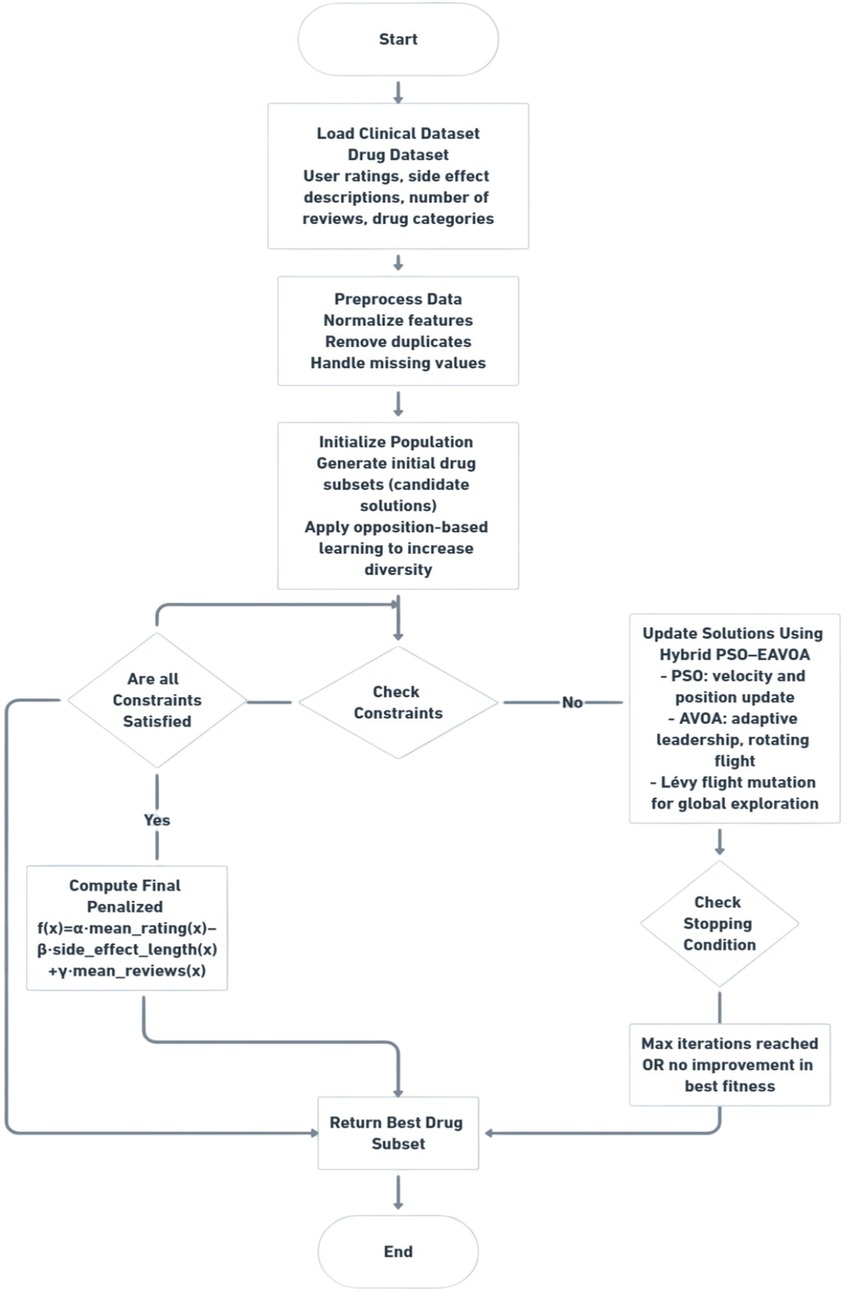
Figure 1. Workflow of the proposed hybrid PSO–EAVOA algorithm for multi-criteria drug selection optimization.
In the hybrid version, to take advantage of both algorithms, the traditional PSO and its personal best position (Pbest) were swapped with BestVulture, which is a position of a selected EAVOA population. This simple switch still allows for strong performance in exploration through the PSO framework, while also utilizing the adaptive and stochastic exploratory behavior of the EAVOA to avoid premature convergence.
The unison of speed of PSO with adaptive and dynamic behavior of EAVOA allows the particles to follow not only their personal best experiences in the search space and the global best solution, but the adaptive intentions of vultures. This type of behavior will make the search process more explorative and varied.
The velocity and position updates in the hybrid are defined as shown in Equations 18, 19:
4 Multi-criteria drug selection optimization
As stated earlier, the objective of multi-criteria drug selection optimization is to identify a collection of drugs that meets multiple criteria: maximize therapeutic effectiveness, minimize side effects and maximize user consensus. Formally, the model views this situation as a constrained, multi-criteria optimization problem, where each solution represents a selection of drugs from a wider clinical dataset.
The optimization problem is formally defined as follows: the real-world drug optimization problem with variable definitions and the associated mathematical formulation as shown in Equations 20–22.
Subject to:
And
where vector of selected drug indices,
objective function with various clinical criteria,
equality constraints restricting selection size and uniqueness,
inequality constraints defining bounds on the search space.
The objective function f(x) was specified to maximize average normalized rating and number of reviews, while minimizing average length of reported side effects:
Where is the vector of selected drug indices.
is weight coefficients are equilibrating the importance of each criterion.
average normalized user rating score of the selected drugs.
average length of keywords of reported side effects, applicable to the selected drugs used.
average number of user reviews for the selected drugs.
Equation 23 is defined mathematically for single optimization objective used by the hybrid PSO–EAVOA algorithm. This weighted-sum formulation contains three normalized evaluation criteria: drug effectiveness, side-effect severity and number of reviews, combined using weighting coefficients are used to control the relevance of each term, they are tuned in the experiments. Theoretical descriptions, pseudocode steps and results from the experiments presented in this work consistently utilize Equation 23 as the fitness function.
4.1 Weighting coefficients sensitivity and ablation analysis
To explore the effect of the weighting coefficients further. There was a complete sensitivity and ablation analysis by () in the fitness function (Equation 23). These coefficients trade off the therapeutic effectiveness, severity of side-effects and user consensus and their change directly affects the convergence behavior of the optimizer and drug recommendations in the end. There were three complementary procedures used in this analysis. To begin with, a one-way sensitivity analysis was performed where all the coefficients are alternated independently to the range [0,1] and the remaining two coefficients are set to their base values (α = 0.5, β = 0.3, γ = 0.2). Second the grid-based exploration was done through testing normalized combinations that met in steps of 0.1 to find out areas with greater fitness values. Lastly, a worldwide sensitivity evaluation by use of Sobel variance decomposition was used to measure the total contribution of every single coefficient to the variance in the objective worth. All the configurations were performed in more than several independent executions of the hybrid PSO-EAVOA optimizer and the optimal and average fitness, convergence stability, overlap of the top-ten recommended drugs and the baseline were obtained. The statistical significance between configurations was tested using either One-way ANOVA or Kruskal Wallis test (). It was possible to identify near-optimal settings of the coefficients and to determine which criterion had the strongest impact on optimization performance by this analysis.
4.2 Variables
The optimization problem formulation requires us to uniquely define appropriate sets of control variables and state variables. These variables are used to represent the characteristics of the candidate solutions and their characteristics in the context of multi-criteria drug selection.
4.2.1 Control variables
The control variables are the variables that the optimization algorithm can directly manipulate to explore the search space. The control variables in the proposed model, are the selection indices of the drugs as shown in Equations 24–26:
where is the index of selected drug indices,
is the targeted number of drugs to select.
D Denotes the total number of drugs in the dataset.
The Control Variables are Subjects to be Bounds and Constraints
And
to ensure all selected indices are valid and unique.
4.3 Constraints
The problem of drug selection optimization has two types of constraints: equality constraints and inequality constraints. These two types of constraints are necessary to ensure that all candidate solutions remain feasible and clinically meaningful within the context of the optimization problem.
4.3.1 Equality constraints
The equality constraints require the exact number of drugs in the chosen set. The equality constraint ensures the optimizer selects exactly the specified number of drugs as shown in Equation 27:
Where is the vector of selected drug indices,
is the targeted number of drugs to select.
4.3.2 Inequality constraints
Each drug index chosen is guaranteed to be unique and suitable for its respective dataset constraints by the inequality constraints. These are the inequality constraints:
4.3.3 Indexing bounds
The Indexing Bounds ensure that each drug index is bounded to lie within the valid bounds of the dataset as shown in Equation 28:
Where Denotes the Total Number of Drugs in the dataset
4.3.4 Uniqueness constraint
In order to achieve clinical validity, there can be no duplicate drugs in a solution. This restriction maintains that there will not be duplicate indices in the control variable vector x. The uniqueness constraint can be written formally as shown in Equation 29:
Where is the number of drugs to be selected and x.
is the vector of selected drug indices. Any instances in which this restriction is not fulfilled are penalized in the fitness function.
4.3.5 Penalty-based fitness modification
In this approach, constraint violations are addressed through the use of penalties to maintain the feasibility and useful nature of the candidate solutions. The final fitness value for each solution is altered by adding penalties for any equality or uniqueness constraint violations. The penalized fitness function is given as follows (Equation 30):
where is the Objective Function Value,
is the adjusted fitness value after applying penalties.
and Penalty coefficients that affect how much constraint violations are weighted.
is the penalty term for violating the equality constraint (i.e., selecting more than or less than the required number of drugs).
is the penalty term for violating the uniqueness constraint (i.e., selecting duplicate drug indices).
Overall workflow of the proposed hybrid PSO–EAVOA algorithm applied to multi-criteria drug selection. The process starts with data pre-processing, population initialization with opposition-based learning, and iterative updates using PSO velocity-state dynamics and adaptive exploration strategies of EAVOA, which is enhanced by Levy flight transformation. The final optimal drug subset is selected by combining the maximization of efficiency ratings, minimization of side effect severity and user consensus.
4.4 Data preprocessing
Preprocessing of the Drugs Side Effects and Medical Condition data set in Kaggle was done to achieve consistency and comparable nature of the data across the features. Missing or otherwise incomplete values were eliminated, and nominal characteristics like drug class and condition label-encoded. The side-effect field text data were cleaned and tokenized as well as lemmatized in order to normalize vocabulary.
Min-Max scaling was used to normalize all quantitative variables, including user ratings, number of reviews and the severity of side-effects to a consistent range of [0,1] as shown in Equation 31:
The severity of side-effect was measured as a weighted score based on a lexicon derived based on the MedDRA with higher weights given to medically serious terms as shown in Equation 32:
This method ensures that all the metrics play an equal role in the optimization process as it offers a strong and interpretative level of negative reaction.
4.5 Complexity and runtime analysis
4.5.1 Computational complexity
The computational complexity of the proposed hybrid PSO–EAVOA algorithm is primarily determined by the total number of fitness evaluations conducted in each iteration. Let represent the population size, T denote the number of iterations and D the number of dimensions of the decision variables. Each candidate solution will need to be evaluated for fitness, have its position and velocity updated and then undergo leader-based adaptive exploration in every iteration (Equation 33). The fitness evaluations entail the most significant cost, leading to a time complexity of
Mutation and Crossover operations are per each iteration without changing the asymptotic order.
4.5.2 Runtime analysis
All experiments were conducted in Google Colab using the Python 3.10 programming language on a virtual machine with an Intel Core i7 processor and 32 GB RAM. For the provided configuration , each benchmark function took between 30 and 60 s to converge, while the clinical drug-selection experiment took about 2–3 min to converge. For the benchmark functions, runtime scaled linearly with the number of iterations and population size, which is in agreement with the analytical complexity estimate.
Pseudo-Code 1: Proposed Hybrid PSO–EAVOA Optimization Process for Multi-Criteria Drug SelectionPseudo Code of the Optimization Process for the Hybrid PSO-EAVOA
1. Initialize parameters: num_particles, max_iter, num_selected, w_max, w_min
2. Set global_best ← ∅, personal_best ← ∅
3. Load and preprocess dataset df: - Remove unnecessary columns - Handle missing values - Normalize rating values - Calculate side effects length - Encode categorical features
4. Initialize particles and velocities randomly
5. Evaluate fitness of each particle using Equation 23
6. Update personal_best and global_best
7. for iter = 1 to max_iter do
8. Update inertia weight:
9. w = w_max—[(w_max—w_min) * iter/max_iter]
10. Update acceleration coefficients: c1 = 2.5—(2.0 * iter/max_iter) c2 = 0.5 + (2.0 * iter/max_iter)
11. Select top-k elite particles → elite_particles
12. for each particle i do
13. if iter > 0.7 max_iter then {Late-stage exploitation}
14. With probability 0.5, replace two genes in particle i with genes from global_best
15. else apply Levy flight perturbation
16. else if iter > 0.4 max_iter then {Balanced exploration–exploitation}
17. influence = global_best—particle_i
18. perturb = randint(−3, 3)
19. exploration_factor = 2–2 * (iter/max_iter)
20. particle_i←particle_i + 0.7 * influence + exploration_factor * perturb
21. else {Early-stage exploration}
22. With probability 0.5:
23. Generate r1, r2 ∼ U(0, 1)
24. Select BestVulture_j from EAVOA population
25. v_i ← w * v_i + c1 * r1 * (BestVulture_ j– particle_i) + c2 * r2 * (global_best—particle_i)
26. particle_i ← particle_i + v_i
27. else apply random perturbation in [−5, 5]
28. if iter mod 20 = 0 then apply Levy mutation to particle_i
29. if no_improve_i ≥ 6 then reinitialize particle_i randomly
30. Ensure particle_i contains exactly num_selected unique indices
31. Compute new fitness of particle_i
32. if new fitness > personal_best_score[i] then
33. Update personal_best[i], personal_best_score[i], reset no_improve_i
34. else increment no_improve_i
35. if new fitness > global_best_score then
36. Update global_best, global_best_score
37. end for
38. Replace worst particle with global_best
39. Preserve top 2 elite_particles
40. Append global_best_score to convergence curve
41. end for
42. Return global_best, global_best_score
Pseudo-Code 1: The proposed hybrid PSO–EAVOA optimization for multi-criteria drug selection. To achieve a balance between exploration and exploitation, the algorithm combines PSO velocity–level updates, EAVOA-inspired exploration dynamics, Levy flight perturbations, and elite protection. This process iteratively updates solutions, preserves heterogeneity, and identifies the optimal drug subset based on multiple clinical criteria (ratings, side effects, and review counts).
5 Application and results
5.1 Computational framework
A Hybrid PSO–EAVOA exploratory optimization framework was implemented on a multi-criteria drug selection problem, which was structured as a combinatorial optimization problem that combined the impact of drugs’ therapeutic effects, safety concerns and collective feedback from users. The data was collected from Kaggle's open-source drug review repository and contained granular records of drug ratings, side-effect profiles, and number of user reviews, giving a representative and varied search space for our optimization. As a complete set of preprocessing steps were implemented to ensure this data was reliable and accessible for the algorithm, data preprocessing involved removing non-informative attributes, complete normalization of drug ratings and review counts, quantifying side-effect text descriptors, and encoding categorical attributes. The combination of these steps enabled a unique modeling of drug prioritization, and offered priority based on balancing both efficacy and safety.
The hybrid PSO–EAVOA algorithm was implemented in Python 3.10 and implemented on a system equipped with an Intel Core i7 processor and 32 GB RAM. The optimization process used a population size of 30 candidate solutions and was evaluated over 500 iterations (10 and 30-run tests) and 1,000 iterations (10 and 30-run tests). The configuration of parameters was established based on the results of preliminary tuning experiments as well as established practices in population-based metaheuristics. A population size of 30 was used in order to keep a sufficient amount of diversity and exploratory power in the population, while still maintaining an acceptable amount of computational time. An iteration range of 500–1,000 was sufficient for an adequate search depth based on the trend of the fitness values, the fitness values were typically stabilizing at around 800 iterations and increasing iterations beyond that only improved the process by trivially amounts. The configuration has also been frequently used in similar types of optimization articles with PSO, EAVOA and hybrid algorithms, showing the stability and suitability for this optimization problem involving multi-criteria. The framework combines adaptive algorithms with dynamically adjusted inertial weights (w) and acceleration coefficients (), to achieve a robust exploration-exploitation trade-off. Additional algorithms such as elite protection and Levy plane-based perturbations, were incorporated to improve population diversity and improve convergence performance.
In comparing performance, the algorithm under consideration is compared to five competing metaheuristics which are believed to be state-of-the-art; Enhanced African Vulture Optimization Algorithm (EAVOA), Particle Swarm Optimization (PSO), Wild Horse Optimization (WHO), Ant Lion Optimization (ALO) and Hippopotamus Optimization Algorithm (HOA). The performance was measured with various measures such as average fitness and best fitness and the convexity path implementation, strength in independent runs. This rigorous evaluation framework provides a comprehensive and statistically robust analysis of the performance of the hybrid PSO–EAVOA in solving real-world, multi-criteria optimization challenges.
5.2 Convergence behavior analysis
Figures 2–5 illustrate the convergence performance of all algorithms evaluated on the 500-iteration and 1,000-iteration test sets, each of which was examined over 10-iteration and 30-iteration runs to ensure stability and reliability. The proposed hybrid PSO–EAVOA demonstrated fast initial convergence, followed by steady refinement in later iterations, effectively maintaining speed and avoiding the premature stagnation observed in PSO and WHO. In comparison, both ALO and HOA were slower explorers and provided suboptimal solutions, while EAVOA performed moderately, but did not provide stability across multiple runs. The superior behaviour of the hybrid model is attributed to its adaptive exploration–exploitation strategy, where dynamically tuned inertia weights and acceleration coefficients preserve diversity among populations. Additionally, perturbations were based on Levy Flights, providing restricted stability that permitted efficient global exploration and movement away from a local optimum, as well as retaining the best performing candidates, enabling elite solution protection that allowed EAVOA to converge more quickly, while providing improved robustness overall.
In Figure 6 shows compare the convergence trends for all optimization algorithms to each other under four experimental configurations, 500 iterations (10 and 30 independent runs) and 1,000 iterations (10 and 30 independent runs). The results clearly show the performance of Hybrid PSO–EAVOA. It achieves the best fitness score and the best convergence results over all competing algorithms. PSO achieves competitive performance but with more variance while EAVOA achieves moderate performance and stability. WHO and HOA are slower at converging, and ALO always has the slowest convergence rate, which suggests ALO did the weakest job at balancing exploration and exploitation. The figure demonstrates that performance and stability improve as iterations and independent run counts increase; however, the Hybrid PSO–EAVOA still outperforms the competing algorithms. Hybrid PSO–EAVOA achieved the best accuracy and stability, which makes Hybrid PSO–EAVOA reliable for complex multi-criteria optimization problems like selecting drugs.

Figure 6. Overall convergence curves of optimization algorithms across All experimental settings (500 and 1,000 iterations, 10 and 30 runs).
5.3 Quantitative results and comparative analysis
The quantitative evaluation of the proposed hybrid PSO–EAVOA algorithm was conducted using a multi-criteria performance framework to ensure a fair comparison with baseline optimizers including PSO, EAVOA, WHO, ALO, and HOA. The performance measurements were derived from a total of four test set-ups: 500 iterations for metrics such as 10 runs and 30 runs; and 1,000 iterations for metrics such as 10 runs and 30 runs. As mentioned above, each algorithm's best fitness, average fitness, standard deviation, and maximum fitness were recorded for the purposes of determining accuracy, consistency and robustness.
Figure 7 provides box plots of the fitness score data to provide basic statistical insights regarding the variation across independent runs. The hybrid PSO–EAVOA consistently shows a high average fitness and tight interquartile range, demonstrating superior consistency compared to competing algorithms. PSO has demonstrated high accuracy, though considerable variation, meanwhile ALO and HOA have clearly demonstrated weak robustness and fitness variability.
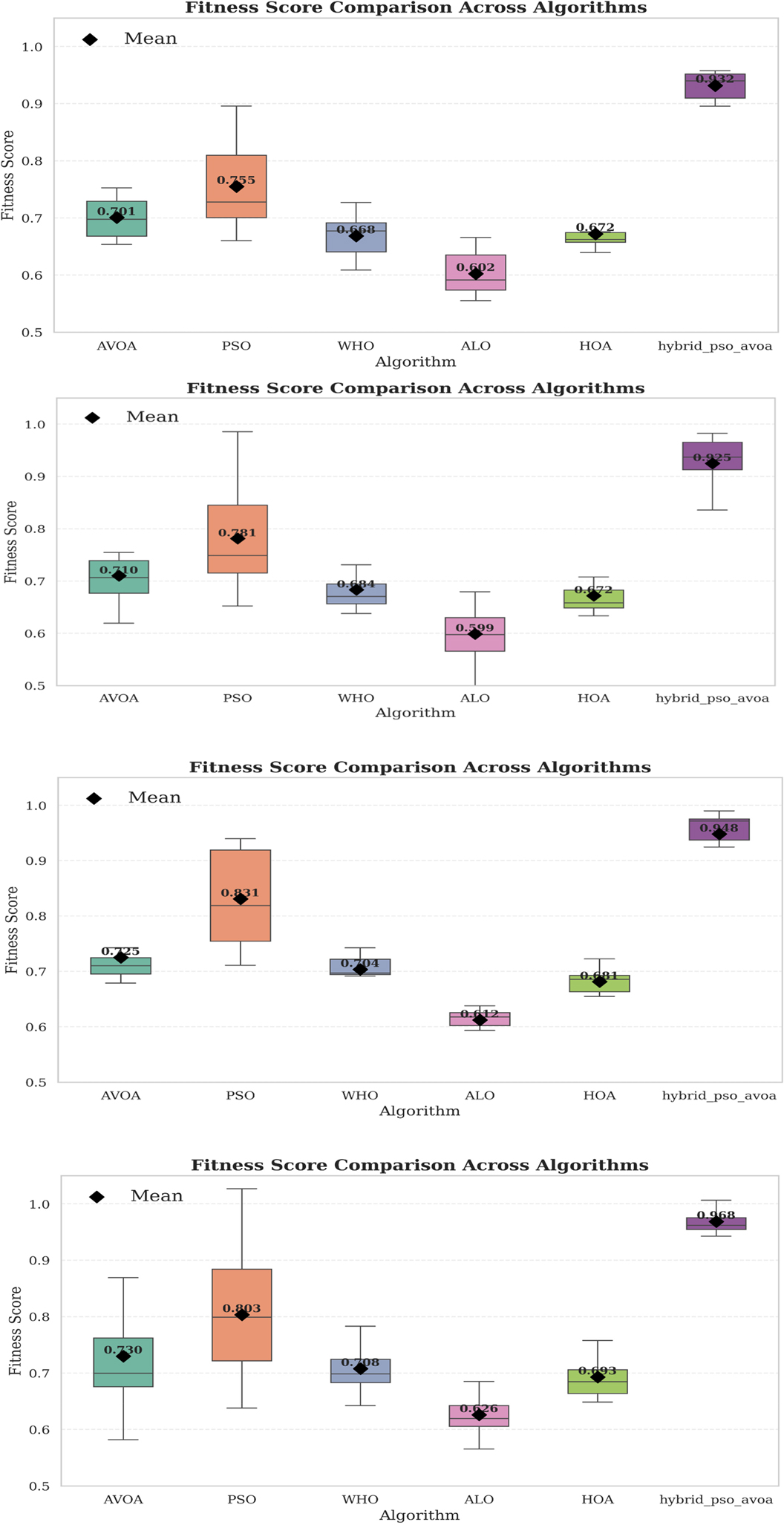
Figure 7. Box plot of fitness score distributions for six algorithms over 10 & 30 independent runs (500 & 1,000 iterations).
Similarly, Figure 8 demonstrates the relative measure of ranking of the mechanisms based on weighted composite scores across all evaluation metrics. Hybrid PSO–EAVOA takes the top spot in every scenario, with PSO emerging as the second best method. EAVOA continues to display moderate performance, stability and consistency, while WHO and HOA provide suboptimal fitness. ALO is consistently very low ranked, which again confirm the weakness of its global search method.

Figure 8. Comparative ranking of algorithms based on weighted scores across different experimental settings (500 and 1,000 iterations; 10 and 30 runs).
Following these visual summaries, detailed numerical results are reported in Tables 1–4, which provide the run-wise fitness values, mean, standard deviation, weighted scores, and final rankings for each test set. It is shown that hybrid PSO–EAVOA consistently achieves the best weighted scores and the highest solution quality, thereby confirming its performance and robustness for multi-criteria drug selection optimization.

Table 5. Overall comparative performance summary of algorithms across experimental settings (500 and 1,000 iterations; 10 and 30 runs).
The results indicate that the hybrid PSO–EAVOA consistently achieves the best weighted scores in all scenarios, outperforming competing algorithms in both solution quality and robustness. In specific, the hybrid model performed the best on variance (least class improvement) while the optimal and mean fitness scores were the highest of the models, again illustrating the hybrid strength of balancing exploration and exploitation. Of the baseline algorithms, particle swarm optimization (PSO) was the second-best performer with acceptable accuracy and high variation while EAVOA had satisfactory stability. WHO and HOA had low fitness and were both slow to converge, ALO consistently ranked the lowest, indicating weak global search capabilities. The comparative performance metrics of the proposed Hybrid PSO-EAVOA and other algorithms are presented in Table 5.
5.4 Optimized drug prioritization
The proposed hybrid PSO–EAVOA optimization framework demonstrated superior ability in identifying clinically meaningful and high-performance drug candidates through a multi-criteria optimization process. This framework offers a more holistic approach to treatment as it assesses patient evaluations, review counts and side effects simultaneously—producing balanced and evidence-informed treatment options which can be prioritized.
As shown in Table 6, the hybrid PSO–EAVOA consistently outperformed the baseline methods (PSO, EAVOA, WHO, ALO, HOA), providing higher fitness scores and clinically relevant drug rankings.There was variation based on recommendation between competing methods, that while reading as a top recommended drug, have not conclusively evidence-based support in clinical trials. In comparison, the proposed model maintained consistency and relationship with the data from the prior runs, essentially ensuring accurate earlier results when considering new information.

Table 6. Top three drug selections identified by hybrid PSO–EAVOA and baseline optimization algorithms.
Based on this comparison, Table 7 lists the final top three drugs that were prioritized exclusively by hybrid PSO–EAVOA:
1. Phentermine (weight loss)—Patient Rating: 8.7; Fitness Score: 1.9076. A consistent first-place ranking across three different treatment options indicates strong therapeutic efficacy and an exceptional benefit-to-risk profile for weight management.
2. Methergine (migraine)—Patient Rating: 9.7; Fitness Score: 0.7974. Clinically demonstrates a relatively high value to treat migraine with robust pharmacological evidence and satisfaction amongst patients.
3. Pernax (acne)—Patient Rating: 10.0; Fitness Score: 0.5887. The valid evaluation demonstrated the excellent therapeutic value and relative adherence from patients.
5.5 Discussion
The proposed hybrid PSO–EAVOA optimization framework demonstrated an exceptional ability to integrate patient-reported outcomes, drug safety profiles and real-world usage data into clinically meaningful drug rankings. By combining EAVOA's robust exploration capability enhanced by Levy Flight perturbations and elite protection with PSO's fast convergence, the algorithm achieved a strong balance between exploration and exploitation, consistently outperforming baseline optimizers. This method has the potential to integrate unstructured real-world evidence and clinical decision-making, allowing for multidisciplinary and multi-criteria evaluation of drugs, taking into account pharmacological efficacy and patient experience. It has scalability for a wide range of applications such as drug repurposing, post-marketing surveillance and personalized treatment planning and its modular configuration allows integration with electronic health records and clinical decision support systems to provide personalized and dynamic recommendations for each patient. In addition to the immediate application of this research, it demonstrates the promising capabilities of hybrid metaheuristic optimization in health care and the development of AI-based precision medicine systems is expected to one day be capable of reducing prescribing errors, improving adherence and accelerating evidence-based decision-making. Three primary evaluation criteria: effectiveness, side effects and number of reviews were specifically chosen in this paper to reflect measurable and patient-centred drug performance indicators. These parameters are present throughout the dataset and reflect the critical balance of therapeutic benefit, tolerability and experiential evidence. An extension to other clinical features, including patient demographics or drug-drug interactions would necessitate structured clinical data, which are usually not available on open review-based sources and may undermine comparability. The existing design guarantees consistency in methodology and clinical interpretability and computational tractability.
6 Conclusion
This work introduced a hybrid PSO–EAVOA optimization framework for multi-criteria drug prioritization, patient perception, side effect profiles and real-world treatment data integration to generate clinically relevant recommendations. By combining the exploratory strength of EAVOA with the fast convergence of PSO, further enhanced by Levy Flight perturbations and elite conservation strategies, the algorithm achieved stable optimization performance and stability over multiple independent runs, outperforming basic metaheuristic algorithms. These findings highlight the power of hybrid metaheuristic development to yield meaningful knowledge from large-scale, unstructured health databases for evidence-based decision making, drug repurposing and personalized treatment planning. In our future work, extend the framework to integrate genomic data, demographic and longitudinal clinical data and pharmacoeconomic data to increase prediction accuracy and generalizability to a clinical setting. Moreover, incorporating this optimization model within ACT-DR capabilities and AI-enabled clinical decision support systems (CDSS) will ensure real-time, dynamic, patient-specific, drug recommendations that will reduce the frequency and magnitude of prescribing errors, improve adherence and convert real-world evidence into clinically relevant solutions.
Data availability statement
The original contributions presented in the study are included in the article/Supplementary Material, further inquiries can be directed to the corresponding author.
Author contributions
MS: Formal analysis, Methodology, Data curation, Writing – original draft, Investigation, Writing – review & editing. NG: Visualization, Conceptualization, Validation, Writing – review & editing, Supervision, Writing – original draft.
Funding
The author(s) declare that no financial support was received for the research and/or publication of this article.
Conflict of interest
The authors declare that the research was conducted in the absence of any commercial or financial relationships that could be construed as a potential conflict of interest.
Generative AI statement
The author(s) declare that no Generative AI was used in the creation of this manuscript.
Any alternative text (alt text) provided alongside figures in this article has been generated by Frontiers with the support of artificial intelligence and reasonable efforts have been made to ensure accuracy, including review by the authors wherever possible. If you identify any issues, please contact us.
Publisher's note
All claims expressed in this article are solely those of the authors and do not necessarily represent those of their affiliated organizations, or those of the publisher, the editors and the reviewers. Any product that may be evaluated in this article, or claim that may be made by its manufacturer, is not guaranteed or endorsed by the publisher.
References
1. Hussien AG, Gharehchopogh FS, Bouaouda A, Kumar S, Hu G. Recent applications and advances of African vultures optimization algorithm. Artif Intell Rev. (2024) 57(12):57–335. doi: 10.1007/s10462-024-10981-2
2. Kim S, Hooker AC, Shi Y, Kim GHJ, Wong WK. Metaheuristics for pharmacometrics. CPT Pharmacomet Syst Pharmacol. (2021) 10(11):1297–309. American Society for Clinical Pharmacology and Therapeutics. doi: 10.1002/psp4.12714
3. Swathi Mirthika GL, Sivakumar B, Hemalatha S. Data-driven drug treatment: enhancing clinical decision-making with SalpPSO-optimized GraphSAGE. Comput Methods Biomech Biomed Engin. (2024):1–23 (ahead of print). doi: 10.1080/10255842.2024.2399012
4. Arunkumar M, Baskaran TS. View of applying chaotic particle swarm optimization for the prediction of drug-to-drug interactions. J Electrical Sys. (2024) 20(7s):1340–5. doi: 10.52783/jes.3707
5. Abualigah L. Particle swarm optimization: advances, applications, and experimental insights. Comput Mater Cont. (2025) 82(2):1539–92. Tech Science Press. doi: 10.32604/cmc.2025.060765
6. Yan J, Hu G, Jia H, Hussien AG, Abualigah L. GPSOM: group-based particle swarm optimization with multiple strategies for engineering applications. J Big Data. (2025) 12(1):114. doi: 10.1186/s40537-025-01140-7
7. Assiri AS, Hussien AG, Amin M. Ant lion optimization: variants, hybrids, and applications. IEEE Access. (2020) 8:77746–64. doi: 10.1109/ACCESS.2020.2990338
8. Zheng R, Hussien AG, Jia HM, Abualigah L, Wang S, Wu D. An improved wild horse optimizer for solving optimization problems. Mathematics. (2022) 10(8):1311. doi: 10.3390/math10081311
9. Pranolo A, Mao Y, Wibawa AP, Utama ABP, Dwiyanto FA. Optimized three deep learning models based-PSO hyperparameters for Beijing PM2.5 prediction. Knowl Eng Data Sci. (2022) 5(1):53. doi: 10.17977/um018v5i12022p53-66
10. Passos LA, Papa JP. A metaheuristic-driven approach to fine-tune deep boltzmann machines. Appl Soft Comput. (2021) 97:105717. doi: 10.1016/j.asoc.2019.105717
11. Varghese JA. (2022). Drugs, Side Effects and Medical Condition, Kaggle. Available: Available online at: https://www.kaggle.com/datasets/jithinanievarghese/drugs-side-effects-and-medical-condition. (Published/Last updated: March 2024).
12. Houssein EH, Saad MR, Hashim FA, Shaban H, Hassaballah M. Levy flight distribution: a new metaheuristic algorithm for solving engineering optimization problems. Eng Appl Artif Intell. (2020) 94:103731. doi: 10.1016/j.engappai.2020.103731
13. Lakbichi R, Zitouni F, Harous S, Ferhat A, Limane A, Almazyad AS, et al. Opposition-based learning techniques in metaheuristics: classification, comparison, and convergence analysis. PeerJ Comput Sci. (2025) 11:e2935. doi: 10.7717/peerj-cs.2935
14. Abdel-Salam M, Askr H, Ella Hassanien A. Adaptive chaotic dynamic learning-based gazelle optimization algorithm for feature selection problems. Expert Syst Appl. (2024) 256:124882. doi: 10.1016/j.eswa.2024.124882
15. Zheng R, Hussien AG, Qaddoura R, Jia H, Abualigah L, Wang S, et al. A multi-strategy enhanced African vultures optimization algorithm for global optimization problems. J Comput Design Eng. (2023) 10(1):329–56. doi: 10.1093/jcde/qwac135
16. Pereira G. (2014). Particle swarm optimization. Available online at: https://www.researchgate.net/publication/228518470 (Retrieved April 15, 2011).
17. Mirjalili S. The ant lion optimizer. Adv Eng Software. (2015) 83:80–98. doi: 10.1016/j.advengsoft.2015.01.010
18. Amiri MH, Mehrabi Hashjin N, Montazeri M, Mirjalili S, Khodadadi N. Hippopotamus optimization algorithm: a novel nature-inspired optimization algorithm. Sci Rep. (2024) 14(1):5032. doi: 10.1038/s41598-024-54910-3
Keywords: hybrid optimization, particle swarm optimization (PSO), enhanced African vulture optimization algorithm (EAVOA), drug prioritization, clinical decision support systems (CDSS), precision medicine
Citation: Suruthi M and Ganesh N (2025) A hybrid PSO-AVOA framework for patient-reported drug prioritization with enhanced exploration and exploitation. Front. Digit. Health 7:1708730. doi: 10.3389/fdgth.2025.1708730
Received: 19 September 2025; Accepted: 21 October 2025;
Published: 12 November 2025.
Edited by:
Björn Wolfgang Schuller, Imperial College London, United KingdomReviewed by:
Tinh Pham Duc, Hanoi University of Industry, VietnamKrassimira Stoyanova, Institute of Information and Communication Technologies (BAS), Bulgaria
Copyright: © 2025 Suruthi and Ganesh. This is an open-access article distributed under the terms of the Creative Commons Attribution License (CC BY). The use, distribution or reproduction in other forums is permitted, provided the original author(s) and the copyright owner(s) are credited and that the original publication in this journal is cited, in accordance with accepted academic practice. No use, distribution or reproduction is permitted which does not comply with these terms.
*Correspondence: Narayanan Ganesh, Z2FuZXNoLm5hcmF5YW5hbkB2aXQuYWMuaW4=
†ORCID:
Manickavasagam Suruthi
orcid.org/0009-0003-0694-2947
Narayanan Ganesh
orcid.org/0000-0002-8880-4673
 Manickavasagam Suruthi†
Manickavasagam Suruthi† Narayanan Ganesh
Narayanan Ganesh